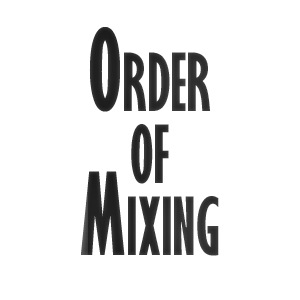Once the recording stage has fully wrapped and it’s time to roll up the sleeves and get to mixing, it can be a big time-saver if you know the best order of mixing, or more specifically the proper order to set your levels.
In this article we’re going to talk about the order of mixing. Keep in mind this is my personal preference and there is no right order as it’s largely subjective and varies from engineer to engineer, but this always works for me.
Before we get started, note that you don’t have to bring all of your tracks all the way down to negative infinite. Just bear in mind proper gain staging which I recently discussed to ensure that nothing is clipping and go from there.
Order of Mixing
First and foremost, you should begin in the busiest point of your song. The point in which the most instruments/tracks are playing is the best starting point, because this gives you an opportunity to set levels when the most is happening.
If you start at a quiet point in the song, or just the intro, then later on you’re going to have a lot more tracks to contend with and find where they relate to where you already placed levels.
Therefore, I like to begin at the busiest point and set everything else relative from that as I work backwards to ending at the quietest or least cluttered bit.
Once you’ve found the busiest point in your song, you’ll likely want to start with your low end. This means your kick and your bass. Note that your bass refers to whatever represents the low end of your mix rhythmically, so this can be a bass guitar, a bass synthesizer, a cello, etc.
If you don’t have a drum track or a bass then identify what makes up the bedrock of your mix and begin there.
Getting back to the low end, isolate your kick and your bass and it’s very important that they are at parity with one another level wise. This means that neither one nor the other is eclipsing the other; they should complement each other perfectly.
There are technical ways to gauge that they are equal, but I always tend to just trust my ears. As long as they’re getting along in the mix and not fighting one another with no other tracks playing, you’re in good shape.
From there you can bring in the rest of your drums and any other percussive instruments which are integral to the rhythm. Once you have a nice blend there, bring in your other rhythmic instruments. This is the rhythm guitars and anything which isn’t a lead. Remember that nothing should be fighting anything else in the mix.
Next you can bring up the lead vocal. Generally you want to place this so that it sits above everything else. This is especially true in pop music but can vary from genre to genre.
Sometimes you want to bury the vocals and showcase another instrument. In some kinds of rock you might bury it in favor of more distorted guitar, or in rap music you may showcase the beat, bass, and general low end.
Whatever the genre, I still find it’s always still a good idea in general to keep those vocals prominent in the mix without going so far that they’re drawing too much attention to themselves to where it sounds off.
After the vocals are where you want them, you can bring in both any backing vocals, lead guitar parts, and lead synthesizer parts you might have. Any kind of arpeggiated lead instrument should be mixed in along with the backup vocals because they deserve as much attention as them. You can think of this class as being like second on the depth chart right behind the true star which is the lead vocal.
Again, remember that this isn’t set in stone. This is just my personal preferred workflow when it comes to the order of mixing.
While all of this may seem overwhelming the first few times you do it and you may not know what you’re listening for all the time, the good news is that the more mixing experience you have under your belt the quicker a process the order of mixing becomes as it becomes more second nature to you.


